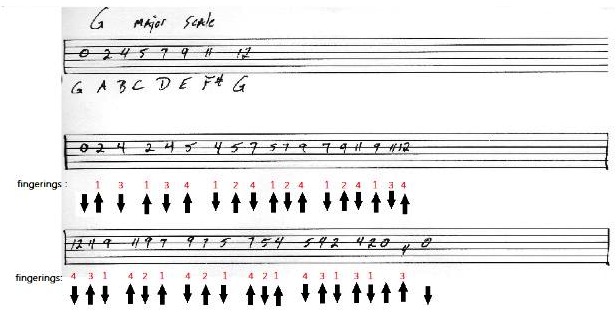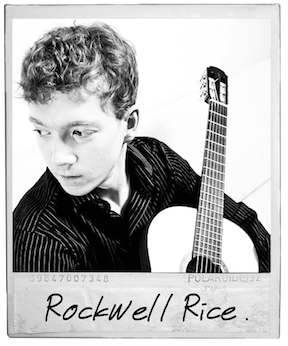Latest Blog
Sep 08, 2016
Sandy the Foundry’s Hospitality Manager is retiring
Apr 07, 2016
If you’ve participated in Rock Workshop, we want to hear from you
Mar 08, 2016
Three tips for performing songwriters
Feb 29, 2016
In Defense of Electronic Music
Feb 15, 2016
Getting Along With Tonight’s Sound Engineer
Blog
Archive
Tags
Aug 27, 2014
Major Scale Soloing on a Single String
by Rockwell Rice
There is no secret to becoming a masterful guitar player. There is no short-cut, only hours of practice. With that in mind I am going to focus this blog post on the art of effective practice habits. I am going to discuss what to practice, when you should practice it, and how to practice it in order to develop mastery. While you can use any exercise you are currently working on with your teacher, I would recommend using the exercise provided as extra material to be working on.
This exercise is a major scale on one string. We are going to use it to develop our ability to alternate pick, change position, and ultimately learn to play effectively by using horizontal movement.
In this example the first thing we will discuss is the alternate picking pattern. For those not familiar with the term alternate picking, it is the process of switching directions when you pick and is usually used to help develop speed and fluidity when playing. The first note is picked with a downstroke and the next note is picked with an upstroke (see image below for tab) and that pattern repeats throughout the exercise. This is marked in the tab below by up and down arrows. If this is something new begin by practicing it slowly along with the level one track just using an open string. Once you have that down come back and start to work it in while playing the scale.
A major scale has a pattern of half and whole steps. For guitarists you can remember that a whole step is the distance of two frets and a half step is from one fret right to the next. In this exercise we are playing a G major scale here which consists of the notes (in order) G - A - B - C - D - E - F# - G.
Can you pick out what notes the half-steps are between?
When practicing this pay special attention to the left hand fingerings, written in red on the tab below. One of the most important aspects to effective practice is to practice consistently. So practice with the fingerings provided. When shifting make sure your thumb moves with the rest of your hand. Sometimes the thumb trails behind because students do not think about moving it with the hand. That will really slow you down so make sure to be actively moving the thumb with your hand in order to maintain the best possible hand position.
To develop the ability to execute this passage quickly and accurately you must practice it with a plan in mind to achieve that goal. Practice this by playing with a metronome.
 Week 1 - Level 1 - Memorize the exercise. You will need to be able to play this from memory in order to work it up to a faster speed so that is the goal of the first week. Focus on the left-hand fingerings and the alternate picking pattern and make sure everything is correct.
Week 1 - Level 1 - Memorize the exercise. You will need to be able to play this from memory in order to work it up to a faster speed so that is the goal of the first week. Focus on the left-hand fingerings and the alternate picking pattern and make sure everything is correct.
Week 2 - Level 2 - Practice at a slow speed, try starting out with a metronome at 60 bpm. Play for 5 minutes, set your alarm on your phone and then just play until it goes off. Do this once per day. If you get off just try to get back on track.
Week 3 - Level 3 - Practice for 5 minutes at 60 bpm (or whatever speed is comfortable) and then play for a minute while increasing the tempo by 5 beats per minutes. Over the course of the week you want to increase the speed you feel comfortable at by roughly 20 bpm
Week 4 - Level 4 - Basically a repeat of week 3. The goal for this week is, again, to increase the speed you can comfortably play at by about 20 bpm.
Keep in mind that any level may take more than one week. That is fine. Just keep going until you are ready to move on. Practicing everyday will make all the difference.
------------
Rockwell teaches lessons on Guitar, Music Theory, Songwriting, Electronic Dance Music Design (EDM) and the classes Classical Guitar Appreciation and Finger-Tapping.
 ROCKWELL RICE
ROCKWELL RICE
Rockwell Windsor Rice is an active performer and teacher based out of Madison WI. He holds a Masters Degree from UW Madison where he studied under Javier Calderon. He also holds a B.A. in music from UW Whitewater where he studied with George Lindquist. His teaching philosophy was created through the combination of starting out as a self-taught guitar player, and ending up as a trained musician. As a teacher he is eager to open students up to the world of music by teaching them to play and understand the music that they love. Beginning as a self-taught player has given him a unique insight into the roadblocks that beginning students encounter, training as a classical guitarist has given him the education to help student avoid those very same roadblocks on their own journey with music. It is his primary goal that students leave their lessons possessing the kind of musical knowledge that will allow them to explore any avenue of music that they want with confidence, and the technique as a guitarist to explore that avenue fully.

